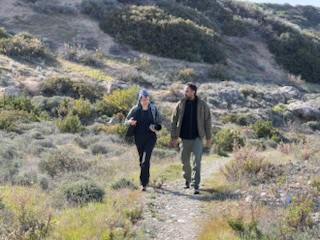29 November 2024 ,By Anete Pošiva-Bunkovska



Two landscapes and their biodiversity stood out to me in the first visit – Kyrenia mountain range with its forests and shrublands, and hilly agricultural areas of Ayia Irini/Akdeniz special environment protection area. Kyrenia mountains displayed interaction of natural shrub habitats formed by steep terrain and weather, combined with forests that are affected by post-fire planting efforts, grazing by goats and outbreaks by Pine Processionary (Thaumetopoea pityocampa). Defoliated pine stands remind of dead spruce stands in Central and Northern Europe where European Spruce Bark Beetle (Ips typographus) has damaged vast areas, with spruce monocultures being the most impacted due to uniform stand age. Forest planting practices geared towards ease of management and harvesting of timber are one of amplifiers of natural pest outbreaks, yet they continue in many countries as it’s hard to change ways of management that have been used and taught by generations of forest managers, despite facing rapid climate change and seeing its impact in various aspects of natural resource management.
High natural value farming practices, on the other hand, are a lesson from previous generations that can be used to preserve ecosystems, their services and a high degree of biodiversity. In terraced barley fields in Ayia Irini/Akdeniz protected area, I had an honour to see first blooms of endemic Cyprus tulip (Tulipa cypria) which is adapted to grow in cultivated fields and their edges, if just the timing of harvest and ploughing is right. Edges between fields were full of blooming orchids, including endemic Cyprus bee orchid Ophrys kotschyi subsp. kotschyi, and of birds. Olive trees dotted the landscape, the most impressive being Monumental Olive Grove with trees exceeding 500 years of age (and still being harvested and managed in the most productive way, by planting other cultures between trees).
Such landscapes and management practices should be encouraged and supported both financially and socially, as they preserve co-existence of nature and culture, and can provide both food for local communities (and other markets) and recreation opportunities for those who don’t want to climb rocky mountain paths or spend all day on a beach. In the competitive market of producing cheaper and cheaper food, small-scale farming in challenging landscapes can’t win, but it can be supported to find its niche markets and persevere.
Anete Pošiva-Bunkovska
Discover MoreThe content of this blog is the sole responsibility of the author and do not necessarily reflect the views of the European Union.



